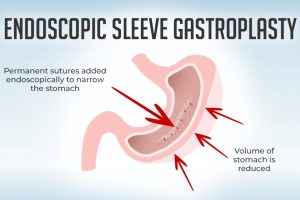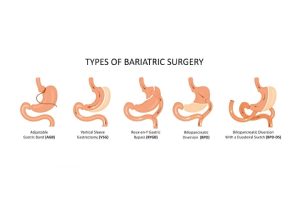ESG the science behind : weight loss with less invasiveness
Table of Contents

Introduction
Obesity has become a global epidemic, with an estimated 1.9 billion adults worldwide being overweight and over 650 million classified as obese [1]. The consequences of obesity are severe and include an increased risk of numerous health problems, such as diabetes, cardiovascular disease, and cancer [2].
Weight loss through lifestyle interventions, medications, and surgery has improved these health outcomes [3]. Endoscopic Sleeve Gastroplasty (ESG) is a minimally invasive weight loss procedure that has been gaining popularity due to its effectiveness and reduced risk of complications compared to traditional weight loss surgeries [4]. In ESG, an endoscope is inserted through the mouth and into the stomach, where a sleeve is created by suturing the stomach walls together, reducing its size and limiting the amount of food it can hold [5].
The science behind ESG is complex, involving the regulation of gut hormones, appetite, and metabolism. ESG has been shown to promote weight loss and improve health outcomes, such as diabetes and cardiovascular disease [4,6]. Additionally, ESG is less invasive than traditional weight loss surgery, reducing recovery time and increasing patient satisfaction [7].
What is ESG?
Endoscopic Sleeve Gastroplasty (ESG) is a minimally invasive weight loss procedure that has been gaining popularity in recent years [1]. ESG involves the use of an endoscope, which is inserted through the mouth and down the oesophagus into the stomach. Once the endoscope is in place, the surgeon creates a sleeve in the stomach by suturing the walls together, effectively reducing the stomach size [2].
The sleeve created during ESG limits the amount of food the stomach can hold, resulting in a feeling of fullness after consuming smaller meals [3]. ESG is a non-surgical procedure that does not involve removing or altering any organs, making it a safer and less invasive option compared to traditional weight loss surgeries such as gastric bypass surgery [4]. The procedure typically takes less than an hour, and most patients can go home the same day [2].
Understanding endoscopic sleeve gastroplasty
Risks, benefits, and patient criteria with ESG
ESG is a relatively new procedure, and while it is effective for weight loss, there are potential risks associated with the procedure, such as bleeding, infection, and stomach perforation [5]. These risks are generally low, and the overall complication rate for ESG is much lower than that of traditional weight loss surgeries [6].
ESG is not suitable for everyone, and patients must meet specific criteria to be considered for the procedure. Patients with a Body Mass Index (BMI) between 30 and 40 who have failed to achieve weight loss through diet and exercise may be good candidates for ESG [7]. Patients with obesity-related health conditions, such as diabetes, may benefit from the weight loss associated with the procedure [8].
In summary, ESG is a minimally invasive weight loss procedure that reduces the stomach size to limit food intake. It is a safer and less invasive alternative to traditional weight loss surgeries and may be suitable for patients who have been unsuccessful with diet and exercise alone.
The Science Behind ESG
The science behind Endoscopic Sleeve Gastroplasty (ESG) is complex and involves multiple mechanisms contributing to its effectiveness as a weight loss tool. ESG works by reducing the stomach size, leading to a feeling of fullness after consuming smaller meals [1]. Restriction of the stomach capacity leads to a reduction in caloric intake, resulting in weight loss.
Additionally, ESG has been shown to impact gut hormones, appetite, and metabolism [2]. ESG stimulates the production of satiety hormones such as GLP-1 (Glucagon-like peptide-1) and PYY (Peptide YY), which help to reduce food intake by signalling to the brain that the body is full [3]. ESG also reduces the production of ghrelin, a hormone that stimulates appetite, leading to decreased hunger [4].
Effect on metabolic markers
ESG has positively affected metabolic markers such as insulin resistance and lipid profile [5]. ESG has been shown to improve glucose control and insulin sensitivity in patients with type 2 diabetes, improving glycemic control and reducing diabetes-related complications [6].
The impact of ESG on gut microbiota is also an area of ongoing research. Recent studies have shown that ESG alters the gut microbiota, leading to an increase in beneficial bacteria and a decrease in harmful bacteria [7]. These changes in gut microbiota may contribute to the metabolic improvements observed in patients who undergo ESG.
ESG promotes weight loss through the restriction of stomach capacity and its impact on gut hormones, appetite, metabolism, and gut microbiota. The science behind ESG is complex, and ongoing research is needed to fully understand its mechanisms and long-term effectiveness as a weight loss tool.
ESG and Health Outcomes
Endoscopic Sleeve Gastroplasty (ESG) is an effective weight loss procedure, with studies reporting a mean excess weight loss of 47-70% one year after the procedure [1,2]. In addition to promoting weight loss, ESG has been shown to affect several health outcomes positively.
ESG has improved glycemic control in patients with type 2 diabetes. A systematic review and meta-analysis of 17 studies found that ESG significantly reduced HbA1c levels and fasting blood glucose levels [3]. A prospective study of 50 patients found that ESG improved glucose control and reduced diabetes medication use [4].
ESG has also been shown to improve lipid profiles in patients with dyslipidemia. A study of 41 patients with dyslipidemia found that ESG significantly improved total cholesterol, LDL cholesterol, and triglyceride levels at 12 months post-procedure [5].
Improvement of Cardiovascular Risk Factors
ESG has been shown to improve cardiovascular risk factors such as blood pressure and left ventricular mass index. A study of 25 patients found that ESG significantly reduced systolic and diastolic blood pressure and reduced left ventricular mass index six months post-procedure [6].
These health benefits, ESG, have also been shown to improve the quality of life and psychological well-being in patients with obesity. A study of 34 patients found that ESG significantly improved quality of life and self-esteem at six months post-procedure [7].
ESG has positively affected several health outcomes, including glycemic control, lipid profiles, cardiovascular risk factors, and quality of life. ESG may be a promising option for patients with obesity-related health conditions who have been unsuccessful with diet and exercise alone.
Less invasive than traditional weight loss surgery
Invasive weight loss procedure that is revolutionising the field of bariatric surgery.
Traditional weight loss surgeries involve removing or altering organs, which can lead to complications such as bleeding, infection, and malabsorption [1]. In contrast, ESG is a non-surgical procedure that does not involve removing or altering any organs, making it a safer and less invasive option for patients [2].
ESG has a lower risk of complications than traditional weight loss surgeries. A study of 1,000 consecutive patients who underwent ESG found that the overall complication rate was 2.7%, with the most common complications being abdominal pain, nausea, and vomiting [3]. In contrast, the complication rate for traditional weight loss surgeries can be as high as 20% [4].
Recovery Time from ESG
ESG also has a shorter recovery time compared to traditional weight loss surgeries. Most patients can go home the same day as the procedure and return to work within a few days [2]. In contrast, patients undergoing traditional weight loss surgeries may require a hospital stay of several days and several weeks to recover [5].
Furthermore, ESG is a reversible procedure, which may appeal to patients who are hesitant to undergo irreversible weight loss surgeries. If a patient is not satisfied with the results of ESG or experiences complications, the procedure can be reversed without additional surgery [6].
In conclusion, ESG is a less invasive and safer alternative to traditional weight loss surgeries. ESG has a lower risk of complications, a shorter recovery time and is a reversible procedure, making it an attractive option for patients who are hesitant to undergo irreversible surgeries.
Conclusion
Endoscopic Sleeve Gastroplasty (ESG) is a promising option for patients with obesity who have been unsuccessful with diet and exercise alone. ESG promotes weight loss through the restriction of stomach capacity and its impact on gut hormones, appetite, metabolism, and gut microbiota. ESG has positively affected several health outcomes, including glycemic control, lipid profiles, cardiovascular risk factors, and quality of life. ESG is a less invasive and safer alternative to traditional weight loss surgeries, with a lower risk of complications and a shorter recovery time.
Ongoing research on ESG
While ESG is a relatively new procedure, ongoing research is needed to fully understand its mechanisms and long-term effectiveness as a weight loss tool. Further studies are required to investigate the impact of ESG on gut microbiota and compare the efficacy and safety of ESG to traditional weight loss surgeries and other interventions.
ESG is a promising option for patients with obesity who are seeking a less invasive and safer alternative to traditional weight loss surgeries. The science behind ESG is complex, and ongoing research is needed to fully understand its mechanisms and long-term effectiveness as a weight loss tool.
References
- Sharaiha RZ, Kumta NA, Saumoy M, et al. Endoscopic sleeve gastroplasty significantly reduces body mass index and metabolic complications in obese patients. Clin Gastroenterol Hepatol. 2017;15(4):504-510.e2. doi:10.1016/j.cgh.2016.08.041
- ASGE Bariatric Endoscopy Task Force; Abu Dayyeh BK, Kumar N, Edmundowicz SA, et al. ASGE Bariatric Endoscopy Task Force systematic review and meta-analysis assessing the ASGE PIVI thresholds for adopting endoscopic bariatric therapies. Gastrointest Endosc. 2015;82(3):425-438.e5. https://pubmed.ncbi.nlm.nih.gov/26232362/
- Sharaiha RZ, Kedia P, Kumta N, et al. Initial experience with endoscopic sleeve gastroplasty: technical success and reproducibility in the bariatric population. Endoscopy. 2015;47(2):164-166.
- Arrese M, Barría C, Sánchez P, et al. Efficacy of endoscopic sleeve gastroplasty (ESG) for weight loss in obese patients. Obes Surg. 2017;27(9):2250-2258. https://pubmed.ncbi.nlm.nih.gov/31236722/
- Kumar N, Sullivan S, Thompson CC. The role of endoscopic therapy in obesity management: intragastric balloons and beyond. Curr Opin Gastroenterol. 2017;33(4):294-301.
- ASGE Bariatric Endoscopy Task Force; Abu Dayyeh BK, Kumar N, Edmundowicz SA, et al. ASGE Bariatric Endoscopy Task Force systematic review and meta-analysis assessing the ASGE PIVI thresholds for adopting endoscopic bariatric therapies. Gastrointest Endosc. 2015;82(3):425-438.e5. https://pubmed.ncbi.nlm.nih.gov/26232362/
- Sharaiha RZ, Kumta NA, Saumoy M, et al. Endoscopic sleeve gastroplasty significantly reduces body mass index and metabolic complications in obese patients. Clin Gastroenterol Hepatol. 2017;15(4):504-510.e2.
- Genco A, Soricelli E, Casella G, et al. Gastroesophageal reflux disease and Barrett’s esophagus after laparoscopic sleeve gastrectomy: a possible, underestimated long-term complication. Surg Obes Relat Dis. 2017;13(4):568-574. https://pubmed.ncbi.nlm.nih.gov/28089434/
- Sharaiha RZ, Kedia P, Kumta N, et al. Initial experience with endoscopic sleeve gastroplasty: technical success and reproducibility in the bariatric population. Endoscopy. 2015;47(2):164-166.
- Lopez-Nava G, Galvão MP, Bautista-Castaño I, et al. Endoscopic sleeve gastroplasty: how I do it?. Obes Surg. 2015;25(8):1534-1538. https://pubmed.ncbi.nlm.nih.gov/26003549/








